|
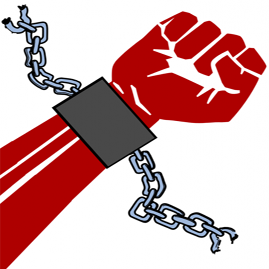 |
CRY FREEDOM.net
formerly known as
Womens Liberation Front
MORE INSIGHT MORE LIFE
Welcome to cryfreedom.net,
formerly known as.Womens
Liberation Front.
A website
that hopes to draw and keeps your attention for both the global 21th. century 3rd. feminist revolution as well and a selection of special feminist artists and
writers.
This online magazine will
be published evey month or if needed more often and started February 2019. Thank you for your time and interest.
Gino d'Artali
indept investigative
journalist,
radical feminist and activist
|
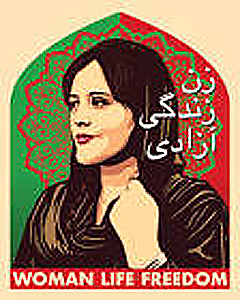 |
|
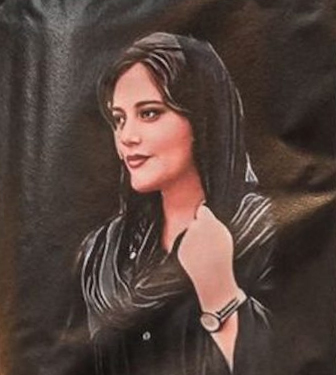

JINA MAHSA AMINI
The face of Iran's protests. Her life, her dreams
and her death.
In memory of Jina 'Mahsa' Amini, the cornerstone of the 'Zan.
Zendagi. Azadi revolution.
16 February 2023 | By Gino d'Artali
And also
Read all about the assasination of the 22 year young Jhina Mahsa
Amini or Zhina Mahsa Amini (Kurdistan-Iran) and the start of the Zan,
Zendagi, Azadi (Women, life, freedom) revolution in Iran
2022
and the latest news about the 'Women Live Freedom' Revolution per month in 2023:
September 30 - 16
--
September 17 - 1
--
August 31
- 18 --
August 15
- 1--
July 31 - 16
--July
15 -1--June
30 - 15--June 15-1--May 31 -16--
May 15-1--April--March--Feb--Jan
And
For all topics below that may hopefully interest you click on the
image:
all updates September 21, 2023
|
'THE NO-HIJABIS
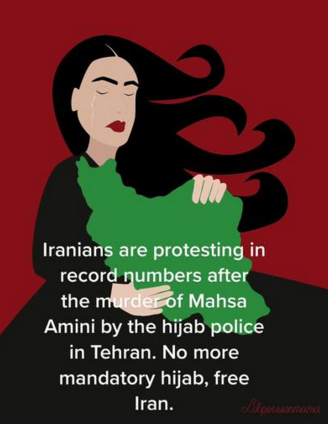
Updated September 27, 2023 |
'BIOLOGICAL
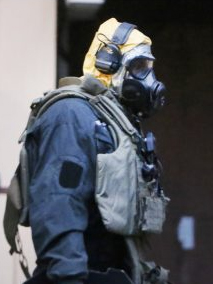
TERROR ATTACKS
AGAINST SCHOOLGIRLS'
Updated September 6, 2023 |
'IRANIAN JOURNALISTS
UNDER SIEGE'

Updated September 19, 2023
|
'BLINDING

AS A WEAPON'
Updated September 21, 2023 |
'THE HANGING SPREE'

Updated September 6, 2023
|
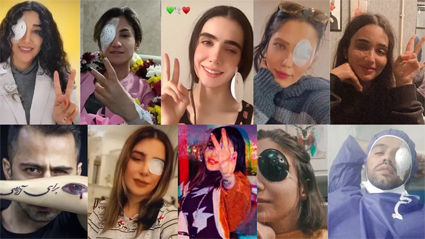
<Persian social media is full of young people who say they were shot in the eye
by security forces>
UPDATES September 21 - 8, 2023
'The cruelty of the mercenaries goes on'
Iranwire - September 21, 2023 - By AIDA GHAJAR
<<Special Report: The Islamic Republic's Use of Blinding as a Weapon of War
Against Protesters
It has been almost six months since Iran's nationwide protests began, triggered
by the death of Mahsa Amini, who died while in the custody of the country's
morality policy. IranWire has in that time identified more than 50 protesters
who have suffered serious injuries to their eyes - and in many cases, blinded -
because of the violent tactics used by Iranian security forces in their attempts
to suppress popular demonstrations in favor of womenís rights and against the
Iranian government. Our investigations will carry on after this report is
published, of course, and IranWire will continue to gather evidence and to
document this crime. The effort to find the victims, or to put it more
accurately, the survivors of this violent and widespread crackdown on the 2022
and 2023 protests, started months ago. Beyond those survivors who have shared
the stories of their injuries on social media, there is a larger group, in more
remote parts of Iran, who remain unknown either because of threats to their
safety or for personal or family reasons. Many others among the injured are
unwilling to disclose their identities because they are afraid of retaliation by
the security forces. Several are from underprivileged groups in Iran and live
under various forms of political and social deprivation and discrimination -
they cannot afford modern means of communication. IranWire nevertheless works to
reach Iranians who do not have smartphones although this does take more time.
Several victims provided their medical records to IranWire and the doctors and
lawyers consulting with us. The records must, of course, be kept confidential.
One of the goals of Iranian security services, when they indiscriminately and
deliberately shoot at the eyes of protesters, must be to teach a lesson to
others; to intimidate and terrorize, so that they might not take to the street
or demand liberty and human rights. But dozens of protesters who were shot
because they were at the forefront of demonstrations have not hesitated: they
have come forward to tell the public their stories and to show photographs of
the injuries to their eyes and other parts of their bodies. At the time of
writing, at least 500 protesters have been killed and at least 580 have lost one
or both eyes. According to doctors and psychologists, losing an eye is one of
the most traumatic experiences a person can have, like learning that one has
cancer. Knowing this can help us feel a stronger sense of empathy with this
group of fighters in the <Woman, Life, Freedom> uprising. They experience this
trauma again and again, each morning, when they open their eyes or whenever they
look in a mirror.The following is our first report on this horrifying tragedy
that, either alone or with subsequent reports, can be presented as evidence at
international criminal tribunals. But even as we work to document these facts,
so that they will not be forgotten, we are also thinking about how to prevent
such outrages from happening again in the future. Who are the real culprits in
this tragedy? And what role do the manufacturers of the weapons used to blind
protesters play in the overall effort to suppress protests? In preparing this
report, we consulted with Katherine Heinet, Omid Shams, a group of doctors
including Dr. Rouzbeh Esfandiari, Dr. David Khorram and others who shall remain
anonymous, the international lawyer Dr. Payam Akhavan and a group of Iranian,
British and French lawyers, and also several Iranian and French sociologists. We
give each of them our special thanks and we remain committed to working
together. The report will updated every Sunday with new case studies and stories
of survivors. You can download the report by clicking on this link - Report
(PDF): https://static.prod.iranwire.com/pdfcomponent/Blinding_as_a_Weapon_of_Suppression_ZcEX.pdf
.>>
Source:
https://iranwire.com/en/features/114739-special-report-the-islamic-republics-use-of-blinding-as-a-weapon-of-war-against-protesters/
Iranwire - September 14, 2023 - by AIDA GHAJAR
<<Blinding as a Weapon: Erfan, Three Bullets Flashing, Complete Darkness
As IranWire has reported, hundreds of Iranians have sustained severe eye
injuries after being hit by pellets, tear gas cannisters, paintball bullets or
other projectiles used by security forces amid a bloody crackdown on mainly
peaceful demonstrations. Doctors say that, as of now, at least 580 protesters
have lost one or both eyes in Tehran and in Kurdistan alone. But the actual
numbers across the country are much higher.
The report concluded that such actions by the security forces could constitute a
<crime against humanity,> as defined by Article 7 of the Rome Statute. In this
series of reports, IranWire presents the victims' stories told in their own
words. Some have posted their stories, along with their names and pictures, on
social media. Others, whose real names shall not be disclosed to protect their
safety, have told their stories to IranWire. IranWire can make their identities
and medical situations available to international legal authorities.
***
In my search for victims who lost their eyes, I traveled to the German city of
Mainz, where I was introduced to Erfan Ramizipour, who was a 19-year-old student
when the nationwide protests erupted last year. On November 16, he was
participating in a protest when he was targeted with a laser. Three shots echoed
through the air, and Erfan collapsed to the ground.
Erfan was only a few months older than my own son, and there he was with an
eyepatch, about to recount the moment he lost one of his eyes. We went to the
library of the Maltzer non-profit foundation in Mainz to meet with Erfan. The
day before, I interviewed Milad Safari, and we recorded several other interviews
too. I had made several attempts to reach out to Erfan while he was in Iran, but
he was preparing to leave the country.
Now, I was eager to convey to him that I never stopped listening to his story,
and I was ready to hear it in full. Upon his arrival at the Maltzer non-profit
foundation, I introduced myself, and we shared a moment of laughter. However, it
wasn't until he disclosed the year of his birth that I truly saw him for who he
was. It felt as if my own son was standing in front of me and I was transported
back to Iran, where countless eyes have been blinded by the actions of the
Islamic Republic. As our video team was preparing to film the interview, we
delved into the subject of people who suffered eye injuries. We recounted
stories of friendships forged under dire circumstances. We named those who had
been threatened, imprisoned or forcibly expelled. As we strolled around the
courtyard of the foundation, I found myself wondering, <If your son came to you
with a bloodied face and in excruciating pain, how would you feel?>
Laser, Gunfire and the Shroud of Darkness
We sat hunched over the laptop, whose screen was displaying a compilation of
videos. It encompassed everything, from footage chronicling the inception of the
protests to motorcycle-mounted agents patrolling the streets, identifying
targets, and discharging ominous green lasers at windows or protesters. In one
video, a green laser ominously settled upon a building's window. At that moment,
our thoughts converged on Benita, a six-year-old girl who was playing on an
apartment balcony when her eyes were struck by pellets. We couldn't help but
ponder what had befallen Benita's mother over the past year. Another video,
captured on November 16, featured Erfan himself, standing alongside a car
engulfed in flames.
He pointed to his image on the screen and said, <This is me.> The laser beam
briefly danced through the smoke before it homed in on Erfan.
Three consecutive gunshots rang out, plunging everything into darkness. The
video abruptly ended.
The succeeding images chronicled a journey of suffering and anguish.
Erfan's agonized moans echoed through the audio as a testament to the
excruciating pain emanating from his eyes. Someone could be seen extracting a
pellet from his hand. Erfan's head, neck and upper chest had been struck.
Another pellet that pierced his forearm was set to be removed the day after our
meeting.
In the Wake of Mahsa's Tragic Death
Mahsa Amini was a 22-year-old woman much like any other, someone who could have
been me, my sister or your sister at the same age. This might explain why so
many young people took to the streets despite the risk of being killed, blinded
or incarcerated. One of those young men who could have easily been my own son
was seated in front of me. Erfan recounted the moment when he heard about the
devastating news of Mahsa's death. He was in the Persian Gulf city of Bandar
Abbas. <After receiving the news of Mahsa Amini's death, we banded together with
our neighbors and fellow students. We divided responsibilities among ourselves
as we planned activities such as distributing leaflets and crafting slogans
during the day and organized street protests,> he said. In the wake of Amini's
death, student organizations kept protesting for months. Local committees were
established and scattered gatherings continued in various neighborhoods.
However, the Islamic Republic was determined to suppress dissent, resorting to
killing, arresting and blinding protesters in the streets and intensifying
repression within the confines of prisons through torture and hefty punishments,
including executions.
When Erfan found himself shot, he told himself, <Erfan, you're done.>
There were two possibilities: either succumb to death or fall into the clutches
of the security agents. His strength resided in his friends. He sensed that he
was not alone, that none of them were alone; they stood together, supporting one
another.
Treated at Home
Picture this: Your child has been struck by a shotgun blast, riddled with
pellets in the face, eyes, neck and shoulders. You witness his excruciating
pain, knowing that immediate treatment at home is your only recourse. Erfan's
eyes were bleeding, and concerned bystanders urgently summoned a nurse. This
nurse discreetly entered through the back door of the house and found Erfan with
10-12 pellets lodged in his head. Lacking the necessary medical equipment and
without using anesthesia, she extracted the pellets from his head.The following
day, Erfan was finally admitted to the hospital. In the most nightmarish moment
of his life, he saw <20-30 beds, each occupied by individuals with injuries to
one or both of their eyes.>
To prevent further complications and potential loss of his eye, Erfan was
transferred to Shiraz, though hopes of regaining his vision remained bleak.
His optic nerve was not irreparably damaged, leaving him with a faint perception
of light. <When someone loses the most vital part of their body, a pervasive
sense of disappointment and sorrow engulfs their being. But I have stated
unequivocally that I shouldn't lament my fate. My eyes were meant to be this
way,> Erfan said, adding, <I took to the streets for a cause I'm deeply proud
of.>
<After the Operations I Stepped Into the Street>
As the surgeries came to an end, Erfan ventured out onto the street and
interacted with the people around him. How could these strangers possibly know
that this young man was one of these protesters who had passionately chanted
slogans and organized rallies? Those protesters were the ones who, for Iranians
residing far from their homeland, have been a source of inspiration. Erfan
returned to Bandar Abbas with his blindfold and visited a friend who had also
been shot. However, as he appeared on the street, individuals in plainclothes
approached him, forced him to the ground and tried to restrain him by binding
his hands behind his back. The intervention of courageous people present at the
scene allowed Erfan to flee and take refuge under a hedge. His eyes were in
agony. He eventually made his way back to Shiraz, fully aware that he risked
being identified, which ultimately convinced him to leave the country. Irfan
solemnly swore to remain committed to the memory of those who lost their lives
or their eyes in the protests and to the tortured detainees. <As long as the
Islamic Republic exists, not only my life but the lives of all Iranians are in
danger,> he said. We concluded our encounter and the lights were turned off. We
walked together for part of the way, discussing various topics but deliberately
avoiding any mention of his eyes. Eventually, we shook hands and Erfan
disappeared from my view. Yet, I couldn't forget his mother, a woman I had
neither seen nor spoken to but whose story remained etched in my mind.>>
Source:
https://iranwire.com/en/blinding-as-a-weapon/120486-blinding-as-a-weapon-erfan-three-bullets-flashing-complete-darkness/
France 24 - September 14, 2023 - by Bahar Makooi
<<Repression in Iran: 'Whoever targeted my eye knew exactly who I was'
'The officer recognised my face in Tehran's Valiasr Square. I had noticed him
over the past three days of demonstrations. On October 1, our eyes met and
everything went black. He had shot me [with a rubber bullet] from three metres
away. The man who shot me in the eye knew who I was. A few days after they
killed Mahsa Amini, I saw demonstrators on Instagram going after the law
enforcement officers that were mistreating them. They were resisting. That same
evening I joined them in the square in Tehran. My friends and I gathered in
groups of seven or eight, sometimes on motorbikes, to demonstrate together. But
I was alone on October 1 when I was shot in the face. I spent two days in Farabi
Hospital in Tehran. Part of my eye had exploded when I was hit and I had to
undergo an emergency operation. I was still confined to bed when a nurse warned
me the next day that two officers were talking about me in the lobby. They had
come to arrest me. I hid in one of the consultation rooms, close to a corridor,
and as soon as I could I left through the courtyard. A hospital security guard
saw me, but he turned around. I don't know if he was too old to run after me or
if he let me get away, in which case I thank him for it.
'Others have gone to the scaffold for less'
I stayed hidden for 12 days, then I flew out of Iran to Turkey with my eye still
bandaged. I was so scared that I was going to be stopped at the airport, because
I couldn't pass unnoticed with the bandage. I was relieved when the plane took
off. I was right to be afraid, because I recently received a summons by email
from the justice ministry saying that I had to appear before a judge. I don't
know exactly what reasons were given, but I know that my file is pretty thick
because I've protested a lot, and I've been speaking my mind for a long time.
They could have sentenced me to death. Others have gone to the scaffold for
less. I soon began to speak out about what had happened to me. I shared a video
of my face on Instagram. I received a lot of messages from other demonstrators
who had suffered the same thing. At that time, very few people dared to talk
about it publicly. Pictures of young people who had been hit in the eyes by
projectiles like I was later started to make the rounds on social media. And
there are still others who have come forward recently.
'I'm doing it for the next generation'
I knew that the authorities had me in their sights. I had already received
threatening text messages from the ministry of intelligence warning me not to
commit the same offences again, especially because I had shared a GIF making fun
of [Iran's Supreme Leader] Ali Khamenei in private chats. I have never censored
myself, either on Instagram or on Facebook. I don't believe in their religion; I
want to be free to choose. For me, sharing and communicating with other people
is vital so that people know what horrors the Islamic Republic is subjecting us
to. I have been demonstrating since 2009 (when protests erupted after the
disputed re-election of president Mahmoud Ahmadinejad) and I protested again in
2017 (against the economic hardships and the regime) and in 2019 (against both
rising prices and the hardline regime). I'm not even doing it for myself. For me
it's too late, I'm 31 years old. I'm doing it for the next generation, so that
they can live freely and enjoy this country's potential, so that no more young
people have to leave Iran. I was working as a consultant in exports and strategy
management for a number of companies in Tehran. I made a pretty good living. I
spent weekends with friends by the Caspian Sea or winters on Kish Island (in the
Persian Gulf). I loved Iran - I was one of the few members of my family who was
still living there. It's a wonderful country that the government has turned into
a polluted prison.
'My left eye will never see again'
Today I live at a refugee centre in Germany; I'm just a migrant. I arrived here
at the end of July. I sent visa requests to a few different European countries
and Germany was the first to get back to me. I had to get out of Turkey as
quickly as possible because I didn't feel safe there. Iran's intelligence
services have a long reach. Nobody was supposed to know where I was living, but
I received photographs of my building warning me that I had been tracked down. I
left my whole life behind in Iran. I left with a single T-shirt. I'm going to
have to start again from scratch and get used to my new face. But here, I can
get care. I consulted a specialist, but unfortunately he told me that my left
eye will never see again. When I was shot, my zygomatic bone (cheekbone) was
also broken. I'm going to have tests done to see if I need an operation. Despite
everything, I'm not one to complain. I left the country easily enough and here I
can start to have a normal life without fearing for my safety. After I left,
some of my close friends were arrested. A few of them were physically tortured.
And they were interrogated about my case. One of them just arrived in Germany as
well. He didn't get a visa, so he came by land, undocumented. On the way, he was
stuck without food or water for five days in a forest in Poland. I can't wait to
see him again. We have a lot to talk about.
This article has been translated from the original in French.>>
Source:
https://www.france24.com/en/asia-pacific/20230914-repression-crackdown-iran-targeted-eye-knew-who-i-was-mahsa-amini-protests
Iranwire - September 8, 2023 - by AIDA GHAJAR
<<Blinding as a Weapon: Laser Light, Gunshots and a Lost Eye
As IranWire has reported, hundreds of Iranians have sustained severe eye
injuries after being hit by pellets, tear gas cannisters, paintball bullets or
other projectiles used by security forces amid a bloody crackdown on mainly
peaceful demonstrations. Doctors say that, as of now, at least 580 protesters
have lost one or both eyes in Tehran and in Kurdistan alone. But the actual
numbers across the country are much higher. The report concluded that such
actions by the security forces could constitute a <crime against humanity,> as
defined by Article 7 of the Rome Statute.
In this series of reports, IranWire presents the victims' stories told in their
own words. Some have posted their stories, along with their names and pictures,
on social media. Others, whose real names shall not be disclosed to protect
their safety, have told their stories to IranWire. IranWire can make their
identities and medical situations available to international legal authorities.
***
....
....
Among them is Milad Safari, a father of two, who lost his sight after being
wounded during the upheaval. Safari chose to leave Iran for the city of Mainz in
Germany - where he hoped to find a brighter future. We have just arrived in
Mainz and are preparing to film our interview with Safari. In the courtyard of
the Maltzer non-profit foundation, overseen by Behrooz Asadi, a political and
civil activist, we meet him. While we are adjusting lights and setting up the
shot, he enters and collapses on to a sofa, engrossed in his phone. He is
mourning a close friend whom he lost just hours earlier. But he also smiles,
though it is perhaps a bitter smile, when his family calls. I approach Safari as
he cradles his head in his hands and sit beside him. A shared smile bridges the
gap between us, and I peer into his eyes, uncertain of how much he can perceive
with the wounded one.
<Why not shield your eyes to prevent further harm?> I ask.
Safari says, <Since the beginning, my children disliked seeing me wear
blindfolds. I don't use them. Instead, I wear a pair of sunglasses whenever
there's too much light and wind.> A father of two, Safari has been following
their well-being day and night through the virtual window of his phone.
Yet, during his time in Iran, Safari admits to being more of a father in image
than in reality. He says he managed to spend a mere day and a half with his
children each week. His routine involved commuting between Kermanshah and
Tehran, a distance of more than 500 km, arriving in Kermanshah on Wednesday
nights and departing for Tehran on Friday evenings. Similar to numerous Iranian
Kurds, Safari's employment prospects in his hometown were limited. He and his
family were therefore left with only one and a half days together each week. The
remainder of his time was spent as a laborer in an unfamiliar city. It was close
to this city, Tehran, that he found himself amid the protests. A laser targeted
his face during the protest and the result was the loss of one of his eyes. It
was September 22 - the sixth night of the protests. On his nights in Tehran,
Safari went to his sister's home in Mehrshahr, Karaj, near the capital, to spend
the night. But that night was different. He joined the protests accompanied by a
friend. The Chahar-Bandeh area of Tehran, characterized by its four lanes,
central boulevard, and a tree, was thronged with people. Safari, not one to
remain passive, urged people near him not to relent. Tear gas was fired by the
police at the demonstrators. Disguised motorcyclists emerged from the rear to
suppress the crowd. Safari moved toward the sidewalk, seeking shelter, when a
green laser pointed at his face. He had been singled out. He shielded his eyes
from the laser as the sound of pellet shots rang out. The echoes of pellets
striking the closed shutters of the shop behind Milad still linger in his
memory. Two pellets pierced his eye. One was later removed - leaving five still
embedded in his body. A pellet remains lodged in his fingertip and Safari
extends his hand to the camera, inviting me, <Feel it.> My fingers touch the
metal fragments within the flesh of his finger. I go back behind the camera. <I
take pride in it. I took to the streets for my convictions, and regardless of
the consequences, it no longer matters,> Safari says. In the nights before the
one that robbed him of his sight, Safari had written a will. Speaking on
Instagram with a friend, he had said, <I'll be on the streets tomorrow. If I
don't return, please take care of my family.>
But he had never imagined that the riot squad's intention was to blind him.
Safari underwent three surgeries on his eye. He removes his glasses, revealing
the stitches. And as he tells his story, there's a simmering undercurrent of
frustration and impatience, particularly when he mentions his mother. Safari
held back the truth about his injured eye from his family until after the second
surgery. Conflicting reports had reached his father and the two arranged to meet
at a park near their home. When he saw his sonís bandaged head and eyes, the
father's legs gave way, and he collapsed on to a park bench. Father and son
embraced, tears mingling in their shared sorrow, their grief intertwining as
they held each other.
And he had yet to break the news to his mother. Safari remembers this episode
with a mixture of anger and emotion. <My mother is an incredibly caring person,>
he says. When she saw her son, her strength faltered, and she fainted and
crumpled to the ground. Safari also dwells on his children - remembering that he
once purchased a toy gun for one of them. While playing, the young boy, wielding
his plastic gun, approached his father and said, <Daddy, cover your eye so I can
shoot.> Safari says, <It's striking that even a four-year-old understands the
significance of protecting one's eyes from harm, while those who caused this
damage failed to grasp it.> When he left Iran, Safari had to cross borders and
travel across countries illegally, until he reached Germany. Speaking with his
children became a source of strength and propelled him on. <The Iranian people
have reached an impasse,> Safari tells me. <Place yourself in Mahsa's family's
shoes. You'd have taken to the streets. What if this had happened to my own
sister?>
He says, <Hatred defines the Islamic Republic for me.>
Safari's life as a Kurdish Iranian, a migrant laborer within his own country,
earns too little to afford a decent life for his wife and children or even a
modest home where they can live together. And seeing his children beyond just
photographs will elude him for years. The interview ends with Safari reflecting
on the rights women enjoy in Germany. Why does the Islamic Republic subject
women in Iran to such violence? We switch the camera off and part ways. Safari
rises and heads to the courtyard. We discuss the future. He needs to learn
German and find a job so that he can bring his family - to embrace his children
as a father. The Islamic Republic injures not only those in its prisons, or on
the streets of Iran, but even people far away in small towns around the world.>>
Source:
https://iranwire.com/en/blinding-as-a-weapon/120245-blinding-as-a-weapon-laser-light-gunshots-and-a-lost-eye/
copyright Womens'
Liberation Front 2019/cryfreedom.net 2023








